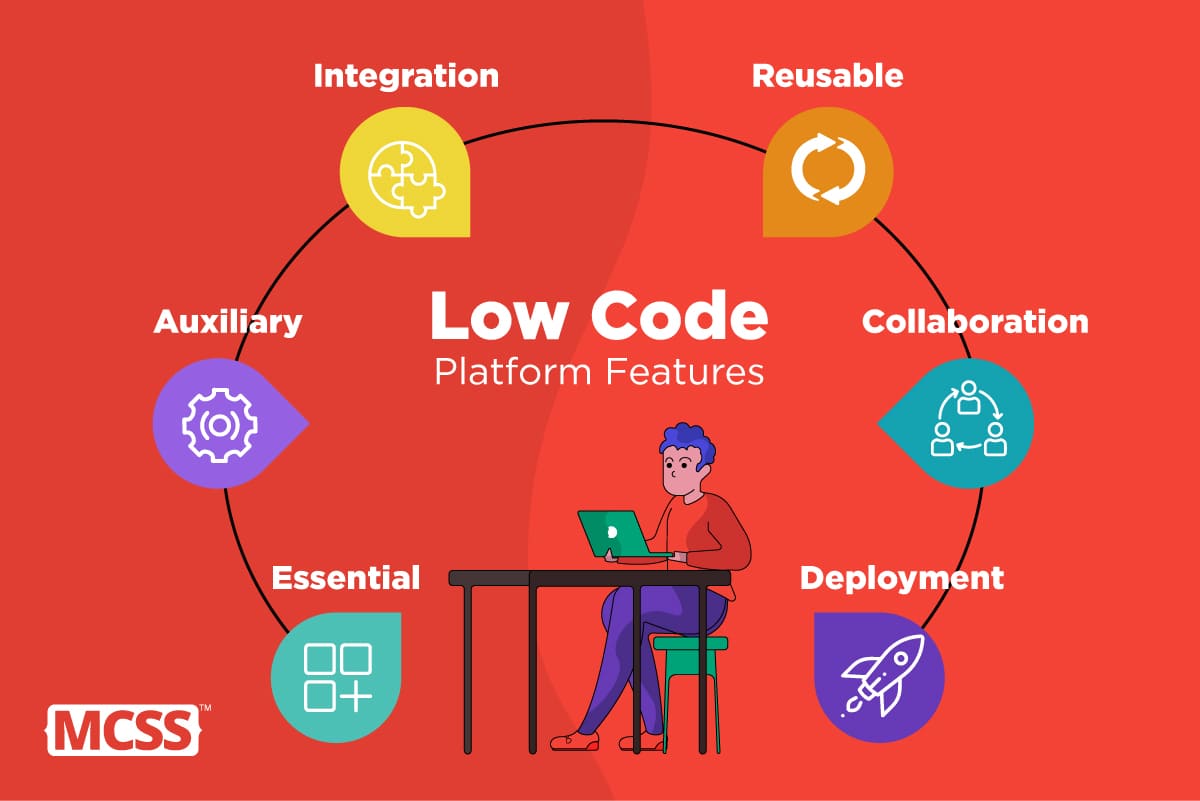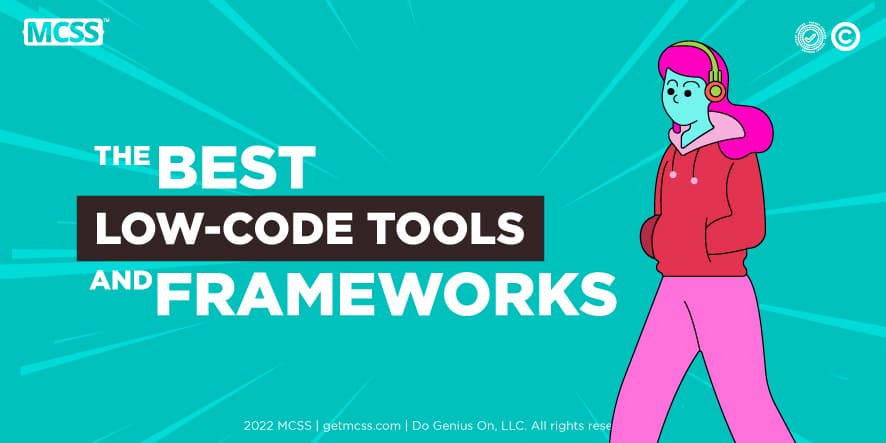What is Low Code?
Low code can be defined as the reduction of code development to the minimum possible. This is achieved through tools using drag and drop technology. Low Code tools require a bit of code to make adjustments and customizations so applications can be adapted to the needs of the client or company.
This article presents a brief list of the best Low-Code tools and frameworks for developers and IT professionals.

By 2025, 70% of new applications developed by enterprises will use low-code or no-code technologies, up from less than 25% in 2020.
Source: Gartner
The best low-code tools and frameworks
MCSS
MCSS is a Low-Code framework that allows the application of style sheets to the development of 100% native mobile applications . It is used to make adjustments to the appearance of native applications. Shares more than 70% of CSS syntax, so any developer with CSS experience can quickly master it. This framework is very helpful to all native app developers, as it speeds up the development time and lowers production costs. It is compatible with most IDEs, including Xcode and Android Studio.
With MCSS your mobile application remains native, which is not achieved with any hybrid technology including React Native. Changes happen instantly, meaning changes you make to an existing app will be visible to users without having to submit a new version to the app store and wait for approval.
Another advantage is the ease of applying web designs, this means that if a client already has a web design and is required to create a native application with the same design, MCSS can use the website's CSS style sheet recognizing at least 70% of CSS syntax, leaving only a small portion of the work remaining in the hands of the developer before releasing the first version.
An important factor to take into account is that this technology is the only one that can be used completely free of charge while the others, some of them have a free trial or DEMO but are paid subscriptions.
Learn more: How MCSS works
Visual Lansa
It is a hybrid Low-Code platform frequently used by IT professionals for the development of business web and mobile apps. It enables development acceleration by eliminating the need to master multiple software development skills. Once the software is created, it can be deployed on an IBM i, Windows, or Linux server.
Its main function is to offer the development of PWA or Progressive Web Applications, with advantages such as fewer calls to the server, having features to share links, and speed up performance a bit, specifically allowing the user to store assets and resources in which web connectivity is low.
Visual Lanza has 2 integrators:
Lanza integrator:
Makes it easier to exchange data from app to app and transfer files between companies, in other words, developers can use an integrator to transform data from one format to another.
Launch Composer:
Simplifies the business process by providing data integration and transformation solution, which includes the transformation of map data into multiple formats and allows the transport of data from source to destination with multiple protocols such as inbound FTP, outbound FTP, inbound HTTP, outbound HTTP, POP3, and SMTP.
Link: Visual Lansa
Comidor
Comidor is also a Low-Code tool used to automate BPM processes, that is, it allows the creation of apps based on processes, also facilitating the use of agile methodologies that require business collaboration, responsibility, and transparency. This platform is used for the digital transformation of organizations that need the management of people, finances, case management, and processes that require approvals.
In Comidor you will be able to:
- Automate processes
- Manage projects
- Automate documents
- Manage HR
- Manage CRM and Sales
- Manage Supply Chain
- Manage Finance
Link: comidor
Power Platform
Also considered as a series of Low-Code tools, the Power Platform that belongs to Microsoft is composed of Power BI applications, Power Apps, Power Automate, and Power Virtual Agents. These are used mainly for the improvement of processes, productivity, and business efficiency.
These tools make it easy to work with data stored by a “Bigdata” company. Therefore Power Platform helps to manage that data correctly, and make decisions based on that data. These tools are designed for non-developers, as it is a Low-Code technology.
We will define them one by one:
Power BI: Platform that allows you to analyze data and create intuitive graphs in a dashboard, where you get answers that bring value to the business. BI also uses artificial intelligence.
Power Apps: It is a set of apps to create apps that capture data that are made manually and then connected with business data stored in platforms such as Microsoft Dataverse, SharePoint, Microsoft 365, Dynamics 365, and others.
Power Automate: the main function is to create process automation, set priorities, generate notifications, and create workflows.
Power Virtual Agents: Allows the easy creation of bots without the need for knowledge of Artificial Intelligence. It is commonly used for customer support with common questions and answers, optimizing the company's time.
Link: Power Platform
Salesforce Lightning
Lightning (Salesforce Lightning) is a low-code platform used for building Salesforce apps. In other words, it is used to automate sales and CRM processes, using the APEX programming language to create extensions on Salesforce.
Among its main functions, we find Experience builder (graphical user interface), Lightning App Builder (creation of apps using drag and drop), Lightning Component Framework (development of reusable components), AppExchange (find partner components), Design System ( find style guides) and Lightning Connect that allows the integration of salesforce with external sources (Odata).
Link: Salesforce Lightning
References
Comidor. (n.d.). Comidor: Low-Code Automation Platform. Retrieved August 14, 2022, from https://www.comidor.com/
Gartner. (2021, 09 20). Magic Quadrant for Enterprise Low-Code Application Platforms . Gartner. Retrieved August 14, 2022, from https://www.gartner.com/doc/reprints?id=1-275QSBDL&ct=210813&st=sb
Kyanon Digital. (2022, April 6). Best Low-Code Development Platforms - Gartner Magic Quadrant . Kyanon Digital. Retrieved August 14, 2022, from https://kyanon.digital/best-low-code-development-platforms-gartner-magic-quadrant/
Lansa. (n.d.). LANSA: Modernize IBM i, Low-Code Dev and Data Integration. Retrieved August 14, 2022, from https://lansa.com/
Microsoft. (2021, September 27). Microsoft is a Leader in the 2021 Gartner® Magic Quadrant™ for Enterprise Low-Code Application Platforms . Microsoft Power Apps. Retrieved August 14, 2022, from https://powerapps.microsoft.com/en-us/blog/microsoft-is-a-leader-in-the-2021-gartner-magic-quadrant-for-enterprise-low-code-application-platforms/
Velneo. (2021, September 28). 7 de las más populares plataformas de desarrollo low-code . Velneo. Retrieved August 14, 2022, from https://velneo.es/las-herramientas-de-desarrollo-low-code-ayudan-a-las-organizaciones-a-realizar-tareas-que-van-desde-simples-formularios-y-sitios-web-hasta-integraciones-de-aplicaciones-y-bpm-a-continuacion-se-prese/

